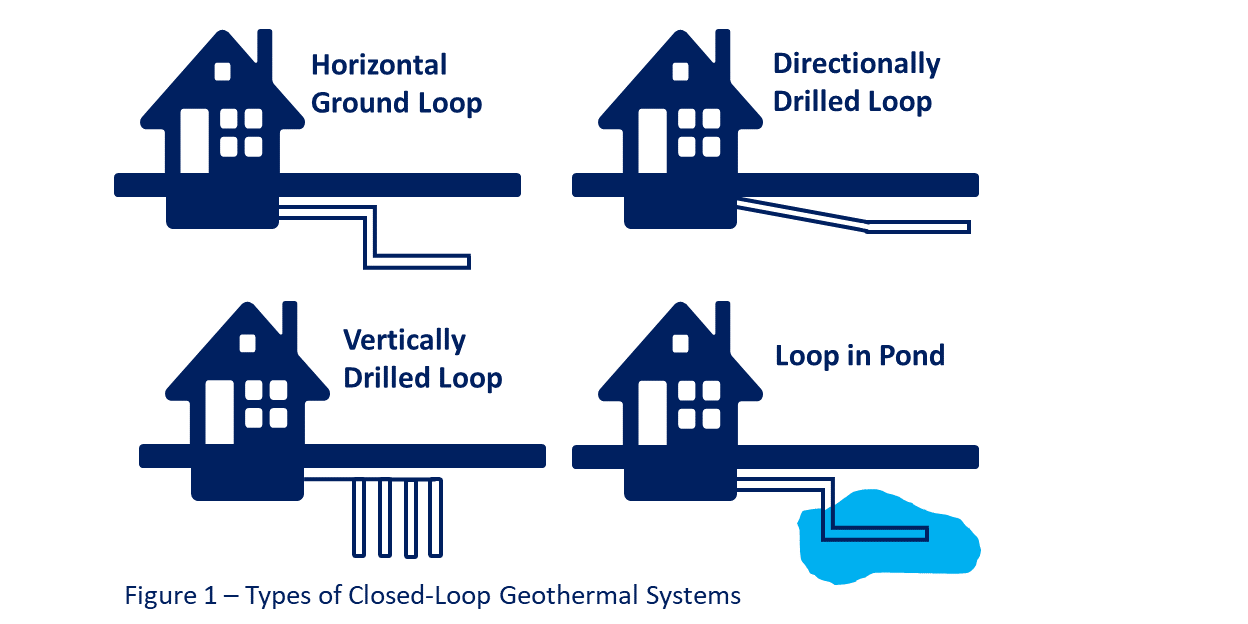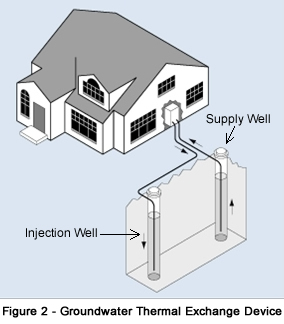Wells and Borings
- Request/Look-up Services
- Wells and Borings Home
- EPA Request: Nitrate
- CEUs
- Construction of Wells and Borings
- Contractors
- Fees
- Laws and Rules
- Licensing
- Minnesota Well Index
- Natural Disasters
- Permits
- Publications
- Resources
- Sealing of Wells and Borings
- Special Construction Areas
- Water Quality and Testing
- Water Information
- Well Disclosure
- Well Partners
Wells Program
Related Topics
- Accredited Laboratories/Well Water Testing
- Clean Water Fund
- Contaminants in Water
- Flooded Wells
- Pesticides
- Water and Health
Environmental Health Division
Geothermal Heating and Cooling Systems
A geothermal system is a heating or cooling system utilizes the earth as a heat source (to obtain heat in winter) or as a heat sink (to discharge heat for cooling in summer). Geothermal systems simply take advantage of the relatively constant temperature within the earth. In Minnesota, the earth’s temperature ranges at 40-50 degrees Fahrenheit at a depth of 50 feet throughout the year.
Geothermal systems have the potential for significant savings in energy costs and for reducing reliance on fossil fuels like oil and natural gas. However, some of these systems also have the potential for adverse environmental effects if installed or operated improperly or if they use inappropriate materials.
Types of geothermal systems
Geothermal systems include a wide variety of designs and operations. These systems may be described by various terms – geothermal heat pumps; earth-coupled heat exchangers; horizontal, vertical, or directional heat exchangers; groundwater-source heat pumps; or groundwater thermal exchange devices. All of these systems include the same basic operation – circulating a fluid that is in contact with the earth through a heat exchanger in order to obtain heat for heating a structure or remove heat when cooling a structure. However, different regulations and requirements may apply, depending on the specific type of geothermal system being installed.
A closed-loop system consists of piping installed in the earth that circulates a heat-transfer fluid through the piping to a heat exchanger and back to the earth in a completely closed-loop. The heat transfer fluid does not come in direct contact with the earth. A closed-loop system may be installed in horizontal trenches, directionally or vertically drilled borings, or even in a surface water body (see Figure 1). Closed-loop systems can be designed to meet a wide range of heating and cooling needs, from an individual house to large commercial buildings.

A open-loop system is a system that pumps groundwater from a water-supply well through a heat exchanger and then discharges the water to the ground surface, an infiltration gallery, a surface water body (lake/river), or an injection well. The discharge from an open-loop geothermal system must never be discharged to a Subsurface Sewage Treatment System (SSTS), sometimes referred to as a septic system. The hydraulic loading may damage the SSTS, causing it to not perform properly. Open loop systems have the potential for adverse environmental impacts, especially when the water is discharged to the ground surface or surface waters. Potential environmental impacts include general warming of surface waters, reduction of lake oxygen levels, and damage to lake ice (a safety concern).
Minnesota Department of Health regulations
The Minnesota Department of Health (MDH) regulates the construction of bored geothermal heat exchangers (BGHE) (closed-loop systems installed in drilled borings) and groundwater thermal exchange devices (GTED) (open-loop systems with a water-supply well – heat exchanger – injection well). The requirements for each of these systems are as follows:
Bored Geothermal Heat Exchanger (BGHE)
A BGHE is a type of closed-loop geothermal system where polyethylene piping is installed in bore holes and heat transfer fluid is circulated through the piping. Minnesota Rules, chapter 4725 establishes requirements for the location, design, construction, testing, repair, and sealing of BGHE systems, including standards for piping materials, heat transfer fluids, and grout mixes.
Bore hole depths for BGHE systems can vary depending on geology, but are commonly 150-200 feet deep. Bore holes must be grouted in order to promote efficient heat transfer between the earth and the piping, support the piping in the bore hole, and prevent contaminants migrating down the bore hole from the surface and contaminating groundwater.
Heat transfer fluids used in BGHE systems must be propylene glycol or ethanol that meets the requirements of Minnesota Rules, part 4725.7050. The requirements minimize the potential groundwater contamination and related drinking water concerns in the event of a system leak. Minnesota Rules, part 4725.7050, subpart 1, item D allows food-grade or United States Pharmacopeia (USP) grade propylene glycol, and ethanol products designed to be used in bored geothermal heat exchanger systems. A propylene glycol with additives, including corrosion inhibitors and dyes, may be used as a heat transfer fluid if it is certified as meeting the NSF Category Code HT1. Ethanol products must be designed by the manufacturer for use in BGHE systems and must not be used unless approved in writing by MDH.
A bored geothermal heat exchanger must be installed by a well contractor or bored geothermal heat exchanger contractor licensed by MDH. Prior to installing this system, an applicant must obtain a BGHE Construction Permit from MDH. For instructions on how to obtain a BGHE Construction Permit, visit: Bored Geothermal Heat Exchanger (BGHE) and Groundwater Thermal Exchange Device (GTED) Construction Permit Applications.
Groundwater Thermal Exchange Device (GTED)

This type of open-loop geothermal system consists of a water-supply well, which provides water to a heat exchanger, and an injection well, used for disposal of the water leaving the heat exchanger (see Figure 2). The supply and injection wells must be completed in the same aquifer, to avoid mixing waters that may have different chemistry. The requirements for the location, design, construction, operation, repair, and sealing of the wells for the groundwater thermal exchange device system are found in Minnesota Rules, chapter 4725, and Minnesota Statutes, section 103I.621.
A groundwater thermal exchange device must be installed by an MDH-licensed well contractor. Prior to installing this system, an individual must obtain a GTED Construction Permit from MDH. For instructions on how to obtain a GTED Construction Permit, visit: Bored Geothermal Heat Exchanger (BGHE) and Groundwater Thermal Exchange Device (GTED) Construction Permit Applications.
Other regulations
Anyone who uses more than 10,000 gallons of water per day or 1 million gallons of water per year requires a water appropriation permit from the Minnesota Department of Natural Resources (DNR). A GTED system that uses more than 10,000 gallons of water per day or 1 million gallons of water per year requires a Well Construction Preliminary Assessment and a water appropriation permit under the permit use type “geothermal groundwater exchange with reinjection (HVAC).” For more information from the DNR, visit: Water Use Permits.
An open-loop system that withdraws groundwater, directs that water through a heat exchanger, and then disposes of that water to the land surface or surface water (sometimes referred to as “once-through” or “pump and dump”) also requires a water appropriation permit from the DNR if more than 10,000 gallons per day or a million gallons per year is withdrawn. Minnesota Statutes, section 103G.271, prohibits once-through cooling/heating systems that withdraw greater than 5 million gallons per year. Since January 1, 2015, the DNR is not allowed to issue a permit for any new once-through geothermal system (i.e., a system that uses between 1 million and 5 million gallons per year). Existing once-through geothermal systems may still require a DNR water appropriations permit. For more information from the DNR, visit: Water Use Permits. If the water is discharged to a surface water body, a National Pollutant Discharge Elimination System (NPDES) permit may also be required by the Minnesota Pollution Control Agency.
A closed-loop system installed in the bed of a public water requires a public waters work permit from the DNR. A permit will not be issued for installations in designated trout streams or designated wild and scenic rivers, where the system poses a navigational hazard, or where the system may damage the aquatic ecology of the water body. For more information from the DNR, visit: Public Waters Work Permit Program.
Of interest
Rulemaking for Bored Geothermal Heat Exchangers
Questions
Well Management Section
651-201-4600 or 800-383-9808
health.wells@state.mn.us
Go to > top